View in other NatureServe Network Field Guides
NatureServe
Montana
Utah
Wyoming
Idaho
Wisconsin
British Columbia
South Carolina
Yukon
California
New York
Dusky Grasshopper - Encoptolophus costalis
Other Names:
Western Clouded Grasshopper
General Description
The following is taken from Hebard (1928), Brooks (1958), Otte (1981), Capinera and Sechrist (1982), Vickery and Kevan (1985), McDaniel (1987), Pfadt (2002), Capinera et al. (2004), Brust et al. (2008), and Scott (2010). This is a medium-sized brown or greenish grasshopper with a large head and dark markings. The forewings have three dark bands, sometimes there are pale stripes along the dorsal edge, converging posteriorly when folded. The hindwings are transparent with a diffused smokey color at the outer third of the tip. The pronotum (thorax) carina is low and cut with one sulcus. The dorsal disk of the pronotum (thorax) bears a light-colored X-marking and linear dark stripes or triangular markings on the metazoan (area behind the sulcus). Females of this species are mostly green, retaining the dark markings of the forewings, but lack markings on the pronotal disk. The outer face of the hind femur has three dark markings. The inner face is pale, with a black area, ring, and knee. The hind tibia is blue, with a light ring near its base.
Communicative behavior/Crepitation*
Crepitation flights are frequent and made by solitary males at a rate of >62 pulses per second. Both males and females crepitate when disturbed with a distinctive buzzing sound. In courtship and aggressive encounters, males vibrate their hind femurs against their forewings producing chirping, trilling, and ticking sounds when the femurs are lowered with the left and right legs alternating making the ticking sound. Both genders perform femur-tipping. Males also use femur-shaking during aggressive encounters (Otte 1970, 1984, and Vickery and Kevan 1985).
*Crepitation is the sound produced by grasshoppers making a clicking or snapping noise with their wings when in flight, during courtship, territorial encounters or being disturbed.
Phenology
The Dusky Grasshopper overwinters in the egg stage. Nymphs begin to occur in early to mid-June. The nymphal period is relatively long, ranging from 56 to 66 days. Adults begin appearing in August to September, sometimes into early October (Otte 1984, Vickery and Kevan 1985, Pfadt 2002, Capinera et al. 2004, and Scott 2010).
Diagnostic Characteristics
The following comes from Hebard (1928), Brooks (1958), Otte (1981), Capinera and Sechrist (1982), Vickery and Kevan (1985), McDaniel (1987), Pfadt (2002), Capinera et al. (2004), Brust et al. (2008), and Scott (2010). The body length to the end of forewings is 16-24 mm for males, and 22-31 mm for females. The wings extend 1-4 mm beyond the abdominal tip.
This species could be confused with other Bandwinged Grasshoppers of similar size with transparent, smokey-colored hind wings, such as
Clear-winged Grasshopper (
Camnula pellucida) and
Kiowa Grasshopper (
Trachyrhachys kiowa).
Species Range
Montana Range
Range Descriptions
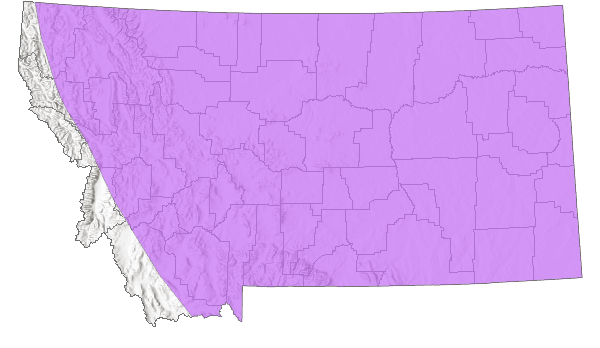
 Native
Native
Range Comments
This species occurs across the Great Plains from Alberta, Saskatchewan, and southwestern Manitoba southward through central Mexico. From the west in Montana, Wyoming, Colorado, and central Arizona, then eastward to western Minnesota, Iowa, Nebraska and through the western two-thirds of Texas. In Montana, it has been found in 37 counties east of the Rocky Mountain Front (Hebard 1928, Otte 1984, Vickery and Kevan 1985, Pfadt 2002, Capinera et al. 2004, and Scott 2010).
Observations in Montana Natural Heritage Program Database
Number of Observations: 11
(Click on the following maps and charts to see full sized version)
Map Help and Descriptions
Relative Density
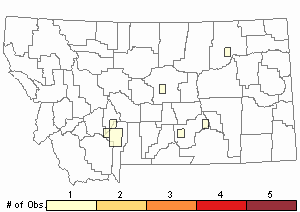
Recency
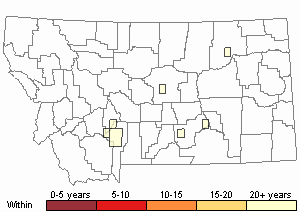
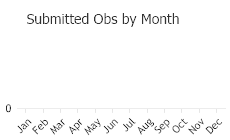
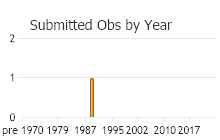
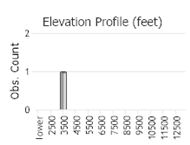 (Observations spanning multiple months or years are excluded from time charts)
(Observations spanning multiple months or years are excluded from time charts)
Habitat
The Dusky Grasshopper inhabits several grassland types: mixedgrass, shortgrass, and bunchgrass prairie, but is most abundant in mixedgrass prairie. It prefers habitats with a rich abundance of grasses and sedges, mixed with bare spots (Otte 1984, Pfadt 2002, and Brust et al. 2008).
Food Habits
The Dusky Grasshopper is primarily a grass feeder, preferring
western wheatgrass (
Elymus smithii) and
needleleaf sedge (
Carex duriuscula), but also consumes
quackgrass (
Elymus repens),
prairie junegrass (
Koeleria macrantha),
sand dropseed (
Sporobolus cryptandrus),
little bluestem (
Schizachyrium scoparium),
side-oats grama (
Bouteloua curtipendula),
Kentucky bluegrass (
Poa pratensis),
foxtail barley (
Hordeum jubatum) and timothy. In some areas, it has been considered a minor pest by feeding on alfalfa (Otte 1984, Pfadt 2002, and Brust et al. 2008).
Reproductive Characteristics
Males make frequent crepitation flights to attract females. These flights also attract other males. Courtship and mating take place on the ground. When an individual, female or male, moves near, the courting male produces a burst of trill stridulations while motionless. Then he moves toward the individual making a single pulse of “ordinary” stridulation. If the individual is a receptive female, she will lower the hind femur closest to the courting male, spread it away from her abdomen and turn her genitalia toward the male as he mounts and copulates. If the attracted individual is a male, he will repel the courter with aggressive femur-tipping and shaking!
Females oviposit in bare ground interspersed with grasses. They test the soil several times by boring with their ovipositors before egg laying. The pods are about ¾ in. long, slightly curved, and contain 14 to 20 tan eggs, measuring 4-4.4 mm long. The hatching period is relatively long over a period of six to eight weeks, which is thought to be due to early or late egg laying in the fall and influenced by soil temperatures. The Dusky Grasshopper passes through 5 instars before reaching the adult stage (Otte 1970, and Pfadt 2002).
Stewardship Responsibility
References
- Literature Cited AboveLegend:
 View Online Publication
View Online Publication Brooks, A.R. 1958. Acridoidea of Southern Alberta, Saskatchewan, and Manitoba (Orthoptera). The Canadian Entomologist (Supplement 9) 90:5-92.
Brooks, A.R. 1958. Acridoidea of Southern Alberta, Saskatchewan, and Manitoba (Orthoptera). The Canadian Entomologist (Supplement 9) 90:5-92. Brust, M.L, W.W. Hoback, and R.J. Wright. 2008. The Grasshoppers of Nebraska. Lincoln, NB: University of Nebraska Extension Service, APHIS.
Brust, M.L, W.W. Hoback, and R.J. Wright. 2008. The Grasshoppers of Nebraska. Lincoln, NB: University of Nebraska Extension Service, APHIS. Capinera, J.L. and T.S. Sechrist. 1982. Grasshoppers of Colorado: Identification, Biology, and Management. Fort Collins, CO: Colorado State University Experiment Station, Bulletin 584S. 161 p.
Capinera, J.L. and T.S. Sechrist. 1982. Grasshoppers of Colorado: Identification, Biology, and Management. Fort Collins, CO: Colorado State University Experiment Station, Bulletin 584S. 161 p. Capinera, J.L., R.D. Scott, and T.J. Walker. 2004. Field Guide to Grasshoppers, Katydids, and Crickets of the United States. Ithaca, NY. Cornell University Press.
Capinera, J.L., R.D. Scott, and T.J. Walker. 2004. Field Guide to Grasshoppers, Katydids, and Crickets of the United States. Ithaca, NY. Cornell University Press. Hebard, M. 1928. The Orthoptera of Montana. Proceedings of the Academy of Natural Sciences of Philadelphia, Vol. 80:211-306.
Hebard, M. 1928. The Orthoptera of Montana. Proceedings of the Academy of Natural Sciences of Philadelphia, Vol. 80:211-306. McDaniel, B. 1987. Grasshoppers of South Dakota. Brookings, SD: South Dakota Agricultural Experiment Station, Bulletin TB 89.
McDaniel, B. 1987. Grasshoppers of South Dakota. Brookings, SD: South Dakota Agricultural Experiment Station, Bulletin TB 89. Otte, Daniel. 1970. A comparative study of communicative behavior in grasshoppers. Miscellaneous Publications, Museum of Zoology, No. 141. Ann Arbor, MI: University of Michigan.
Otte, Daniel. 1970. A comparative study of communicative behavior in grasshoppers. Miscellaneous Publications, Museum of Zoology, No. 141. Ann Arbor, MI: University of Michigan. Otte, Daniel. 1981. The North American Grasshoppers. Volume 1. Acrididae (Gomphocerinae and Acridinae). Harvard University Press. 275 pp.
Otte, Daniel. 1981. The North American Grasshoppers. Volume 1. Acrididae (Gomphocerinae and Acridinae). Harvard University Press. 275 pp. Otte, Daniel. 1984. The North American Grasshoppers Volume II. Acrididae (Oedipodinae). Harvard University Press. 366 pp.
Otte, Daniel. 1984. The North American Grasshoppers Volume II. Acrididae (Oedipodinae). Harvard University Press. 366 pp. Pfadt, R.E. 2002. Field Guide to Common Western Grasshoppers, 3rd edition. Laramie, WY: Wyoming Agricultural Experiment Station, Bulletin 912, modified by S. Schell and S. Schell for electronic publication. Accessed 19 February 2020. http://www.uwyo.edu/entomology/grasshoppers/field-guide/index.html#fieldguidetoc
Pfadt, R.E. 2002. Field Guide to Common Western Grasshoppers, 3rd edition. Laramie, WY: Wyoming Agricultural Experiment Station, Bulletin 912, modified by S. Schell and S. Schell for electronic publication. Accessed 19 February 2020. http://www.uwyo.edu/entomology/grasshoppers/field-guide/index.html#fieldguidetoc Scott, R.D. 2010. Montana Grasshoppers, Katydids, and Crickets A Pictorial Field Guide to the Orthoptera. MagpieMTGraphics, Billings, MT.
Scott, R.D. 2010. Montana Grasshoppers, Katydids, and Crickets A Pictorial Field Guide to the Orthoptera. MagpieMTGraphics, Billings, MT. Vickery, V. R. and D. K. M. Kevan. 1985. The grasshopper, crickets, and related insects of Canada and adjacent regions. Biosystematics Research Institute, Ottawa, Ontario. Publication Number 1777. 918 pp.
Vickery, V. R. and D. K. M. Kevan. 1985. The grasshopper, crickets, and related insects of Canada and adjacent regions. Biosystematics Research Institute, Ottawa, Ontario. Publication Number 1777. 918 pp.
- Additional ReferencesLegend:
 View Online Publication
View Online Publication
Do you know of a citation we're missing? Anderson, N.L. 1951. Field studies on the biology of range grasshoppers of southeastern Montana. M.Sc. Thesis. Bozeman, Montana: Montana State University. 96 p.
Anderson, N.L. 1951. Field studies on the biology of range grasshoppers of southeastern Montana. M.Sc. Thesis. Bozeman, Montana: Montana State University. 96 p. Anderson, N.L. 1962. Grasshopper-vegetation relationships on Montana grasslands. Ph.D Dissertation. Bozeman, Montana: Montana State University. 73 p.
Anderson, N.L. 1962. Grasshopper-vegetation relationships on Montana grasslands. Ph.D Dissertation. Bozeman, Montana: Montana State University. 73 p. Gillespie, R.L.1992. Dynamics of grasshoppers (Orthoptera: Acrididae) at a rangeland-crop interference. Ph.D. Bozeman, MT: Montana State University. 111 p.
Gillespie, R.L.1992. Dynamics of grasshoppers (Orthoptera: Acrididae) at a rangeland-crop interference. Ph.D. Bozeman, MT: Montana State University. 111 p. Helfer, J.R. 1971. How to Know the Grasshoppers, Crickets, Cockroaches, and Their Allies. Revised edition (out of print), Mineola, NY: Dover Publications.
Helfer, J.R. 1971. How to Know the Grasshoppers, Crickets, Cockroaches, and Their Allies. Revised edition (out of print), Mineola, NY: Dover Publications. Kirk, K. and C.R. Bomar. 2005. Guide to the grasshoppers of Wisconsin. Madison, WI: Wisconsin Department of Natural Resources, Bureau of Integrated Science Services PUB-SS-1008. 154 p.
Kirk, K. and C.R. Bomar. 2005. Guide to the grasshoppers of Wisconsin. Madison, WI: Wisconsin Department of Natural Resources, Bureau of Integrated Science Services PUB-SS-1008. 154 p. Larson, D.P. 1996. Evaluation of sweep sampling as a method for determining grasshopper community composition on rangeland. M.Sc. Thesis. Bozeman, MT: Montana State University. 92 p.
Larson, D.P. 1996. Evaluation of sweep sampling as a method for determining grasshopper community composition on rangeland. M.Sc. Thesis. Bozeman, MT: Montana State University. 92 p. Sater, S. 2022. The insects of Sevenmile Creek, a pictorial guide to their diversity and ecology. Undergraduate Thesis. Helena, MT: Carroll College. 242 p.
Sater, S. 2022. The insects of Sevenmile Creek, a pictorial guide to their diversity and ecology. Undergraduate Thesis. Helena, MT: Carroll College. 242 p. Skinner, K.F. 1995. Plant and grasshopper community composition: indicators & interactions across three spatial scales. M.Sc. Thesis. Bozeman, MT: Montana State University. 144 p.
Skinner, K.F. 1995. Plant and grasshopper community composition: indicators & interactions across three spatial scales. M.Sc. Thesis. Bozeman, MT: Montana State University. 144 p.
- Web Search Engines for Articles on "Dusky Grasshopper"
- Additional Sources of Information Related to "Insects"





